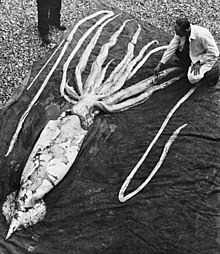深海巨大症
動物学において、深海巨大症(しんかいきょだいしょう、英語: deep-sea gigantism, abyssal gigantism)は、無脊椎動物や他の深海で生活する動物種が、浅いところに棲む近縁の動物よりも大きくなる傾向のこと。深海での少ない食料資源、高い圧力、低い温度への適応などからの説明が提案されている。

分類学上の範囲
編集| “ | Other [animals] attain under them gigantic proportions. It is especially certain crustacea which exhibit this latter peculiarity, but not all crustacea, for the crayfish like forms in the deep sea are of ordinary size. I have already referred to a gigantic Pycnogonid [sea spider] dredged by us. Mr. Agassiz dredged a gigantic Isopod eleven inches in length. We also dredged a gigantic Ostracod. For over 125 years, scientists have contemplated the extreme size of Bathynomus giganteus. – Henry Nottidge Moseley, 1880[1] | ” |
深海巨大症の例としては、ダイオウグソクムシ[1]、giant ostracod[1]、ヨロイウミグモ[1]、giant amphipod、タカアシガニ、リュウグウノツカイ、ウスエイ、カンテンダコ[2]、多くのイカの種類(ダイオウホウズキイカ(体長最大14 m)[3]、ダイオウイカ(最大12 m)[3]、ニュウドウイカ、Taningia danae, Galiteuthis phyllura, Kondakovia longimana, bigfin squid)が挙げられる。
説明
編集海棲の甲殻類の場合、深さとともにサイズが大きくなるのは、緯度とともにサイズが大きくなるのと同じ理由(ベルクマンの法則)であるということが提案されている。どちらの傾向も温度低下とともにサイズが大きくなることが含まれている[4]。深さに伴うこの傾向はアミ、オキアミ、十脚目、ワラジムシ目、端脚類で観察される[4]。いくつかの同じ群において、緯度の傾向は広く分布している種同様関連種の比較においても観察されている[4]。温度が下がった結果、細胞の大きさが大きくなり寿命が長くなると考えられる。このどちらもが最大のサイズが増えることにつながる(生きている限り継続的に成長するのは甲殻類の特徴である)[4]。垂直方向の温度勾配が小さくなる北極海および南極海では、静水圧が重要な要素であることに反し体の大きさが深くなるにつれて大きくなるという傾向もある[4]。
巨大チューブワームの大きさに影響を与えるうえで、温度が同様の役割をしているとは思われない。2-30℃の周囲温度で熱水噴出孔に生息するRiftia pachyptilaは[5]、冷水湧出帯に生息するLamellibrachia luymesiに匹敵する2.7 mの長さに達する。しかし、前者は急速に成長し寿命が約2年と短いのに対し[6]、後者はゆっくり成長し250年以上生きることができる[7]。
ギャラリー
編集脚注
編集- ^ a b c d McClain, Craig. "Why isn't the Giant Isopod larger?". Deep Sea News. Retrieved 1 March 2018.
- ^ Hoving, H. J. T.; Haddock, S. H. D. (2017-03-27). “The giant deep-sea octopus Haliphron atlanticus forages on gelatinous fauna”. Scientific Reports 7: 44952. doi:10.1038/srep44952.
- ^ a b Anderton, Jim (22 February 2007). “Amazing specimen of world's largest squid in NZ”. New Zealand Government. 23 May 2010時点のオリジナルよりアーカイブ。2019年2月閲覧。
- ^ a b c d e Timofeev, S. F. (2001). “Bergmann’s Principle and Deep-Water Gigantism in Marine Crustaceans”. Biology Bulletin (Russian version, Izvestiya Akademii Nauk, Seriya Biologicheskaya) 28 (6): 646–650 (Russian version, 764–768). doi:10.1023/A:1012336823275.
- ^ Bright, M.; Lallier, F. H. (2010). “The biology of vestimentiferan tubeworms”. Oceanography and Marine Biology: An Annual Review (Taylor & Francis) 48: 213–266. doi:10.1201/ebk1439821169-c4 2013年10月30日閲覧。.
- ^ Lutz, R. A.; Shank, T. M.; Fornari, D. J.; Haymon, R. M.; Lilley, M. D.; Von Damm, K. L.; Desbruyeres, D. (1994). “Rapid growth at deep-sea vents”. Nature 371 (6499): 663. doi:10.1038/371663a0.
- ^ MacDonald (2002年). “Stability and Change in Gulf of Mexico Chemosynthetic Communities” (PDF). MMS. 2013年10月30日閲覧。